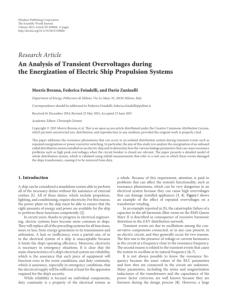Vessel design, maintenance, & management 1990 - 2017

This document, published in 1995, contains the welding
and allied processes (except brazing) and casting
requirements, including inspection for the fabrication,
alteration, or repair of any item or component of
machinery, piping, and pressure vessels in the United
States Navy ships.
Reference USN: 9074-AR-GIB-010/278

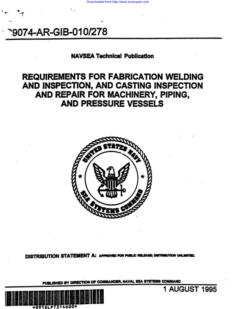

This document discusses the certification process of the
weight and stability of vessels
Reference USN: S9086-C6-STM-010_CH-096R1
Date: 2 August 1996

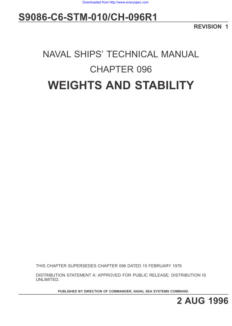

This document describes the various fabrication of wire
ropes and procedures to install and maintain them
properly.
Reference USN: S9086-UU-STM-010_CH-613R3
Date: 30 October 1999



This document describes towing procedures in force in
the US Navy.
Reference USN: SL740-AA-MAN-010_REV-3
Date: 1 July 2002

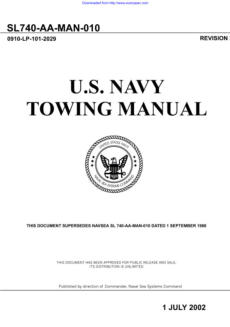

Abstract:
A new strategy for active control in heavy-lift offshore
crane operations is suggested, by introducing a new
concept referred to as wave synchronization.
Wave synchronization reduces the hydrodynamic forces
by minimization of variations in the relative vertical velocity
between payload and water using a wave amplitude
measurement.
Wave synchronization is combined with conventional
active heave compensation to obtain accurate control.
Experimental results using a scale model of a semi-
submerged vessel with a moonpool shows that wave
synchronization leads to significant improvements in
performance.

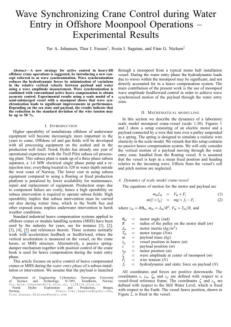

This catalog contains general guidance to the U.S. Navy
Surface fleet for cleaning products authorized by the
Naval Sea Systems Command for use onboard U.S. Navy
surface ships only published in September 2004.
This catalog contains the following information:
- A list of authorized chemical cleaning products
- The precautions required for these products.
- The containment requirements.
- A list of authorized dispensing systems.
Reference USN: S6480-A4-CAT-010_R1-1

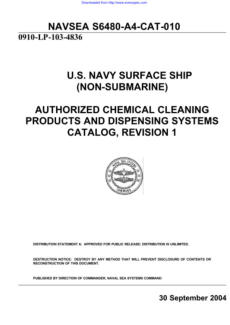

The purpose of this manual is to establish safety guidelines
for the selection, design, testing, evaluation, use,
packaging, storage, transportation, and disposal of lithium
batteries.
Reference USN: NAVSEA S9310-AQ-SAF-010
Date: 19 August 2004

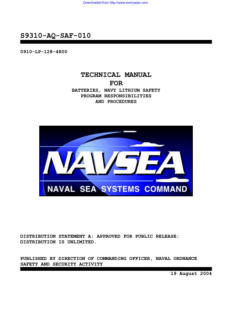

This article reviews the main design criteria of fixed pitch
propellers (FPP) and controllable pitch propellers (CPP)
installations for various applications, focusing on the
common design criteria for both concepts and the special
considerations concerning controllable pitch propellers.

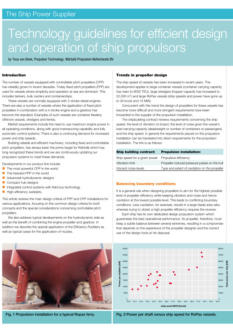

Explosives can be used to demolish and install offshore
and onshore structures, which require specific precautions
for their storage and handling.
This US Navy publication defines the hazards arising from
electromagnetic radiations to ordnance and provides
approved methods or procedures for minimizing
accidents resulting from these hazards.
Ref. USN: NAVSEA OP3565 NAVAIR 16-1- 529 R16-V2
Date: 1 August 2006

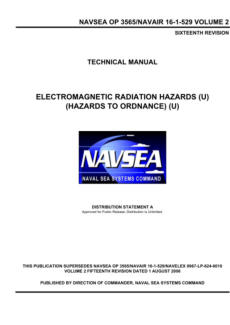

This document discusses the administrative US Navy
procedures, including description, maintenance, handling
equipment, and repair of boats and small craft. In addition,
operating procedures, safety precautions, testing, and
inspection requirements are covered.
Although this document has been written for militaries, it
can be a source of suitable suggestions to write a
company policy.
Reference USN: S9086-TX-STM-010 (VOL-1-REV-5)
Date: 30 May 2006

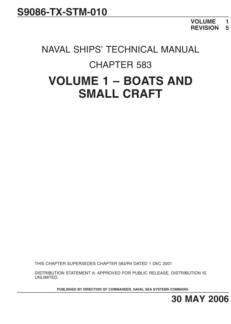

Electromagnetic Interferences are unwanted signals that
disrupt, obstruct, or degrade electronic equipment
performances. The potential sources of such emissions are
alternative current units, alternators, battery chargers,
blower fans, engines, generators, current inverters,
propeller shafts, radars, electrical wiring, etc.
This US Navy document, published in 1996 and reviewed
in 2010, provides guidelines for designing and installing
electrical cables, cableways, and shielding associated with
electrical and electronic systems installed aboard
submarines, in below decks areas of surface ships, and
many shore-based installations.
Even though this document is primarily written for military
systems, most of its guidelines can be transposed to diving
and ROV support vessels.
Reference USN: S9407-AB-HBK-010 REV-2 CHG-2

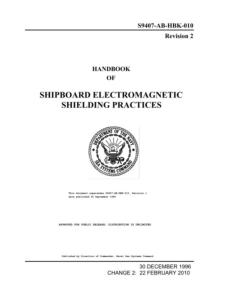

This document primarily covers the use and installation of
threaded fasteners to repair and maintain shipboard
equipment. It does not cover use or installation for many
types of non-threaded mechanical fasteners (such as
rivets, bands, lock rings, and clamps). Nor does it cover
threaded fastener design and selection for specific
applications.
Reference USN: S9086-CJ-STM-010
Date: 30 April 2006



This document provides useful guidelines that can be
used in addition to those from IMO and IMCA for the
inspection and the maintenance of electrical system of
diving & ROV support vessels,
Reference USN: S9300-A6-GYD-010 REV-2.
Date: 15 September 2011

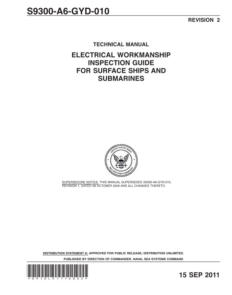

This US Navy manual provides requirements and
guidance for the survey, assessment, and repair or
replacement of coatings and structures on surface ships. It
also contains requirements and guidance concerning the
concurrent evaluation of structural supports for selected
ancillary equipment such as tank level indicators, ladders,
piping system components, anodes, etc.
Reference USN: T9630-AB-MMD-010 REV-3
Date: 30 June 2015

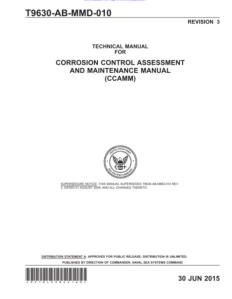

This paper describes the steps involved in controlling and
automating a hydraulic boom knuckle crane, which is
used to position loads with accuracy and repeatability in
the shortest possible time.
Note:
A knuckle crane is a crane whose boom is articulated near
the middle, allowing it to fold back like an arm.

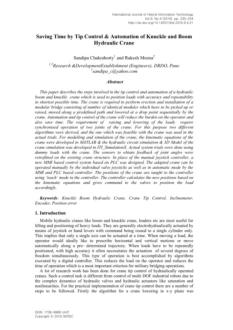

Authors: E. A. Tannuri and C.P.Pesce
This document is an analysis of a Dynamic Positioning
(DP) system to be installed in an already existing pipeline-
laying barge. To feed a numerical simulator, small-scale
model experiments have been carried out, addressing
either current as well 'wind' forces.
Two laying conditions have been considered: S-Lay, for
intermediate deep waters, and J-Lay, for deeper waters,
up to 1000 meters.

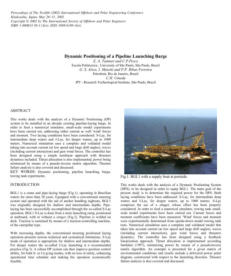

Authors: Leszek Chybowsky, Zbigniew Matuszak.
Construction support vessels are commonly used in the
offshore Industry. These vessels are fitted with dynamic
positioning (DP) systems that automatically maintain the
ship’s defined position and heading. To ensure a given
level of safety and reliability, most of the DP subsystems
are subject to redundancy. This document presents the
application of a redundancy model proposed by the
authors.

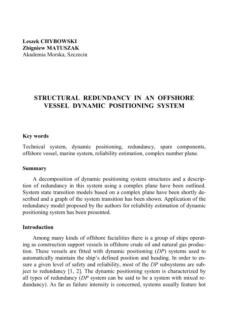

This Code of Safe Working Practices is intended primarily
for merchant seamen on the United Kingdom registered
vessels.
Copies of the current printed edition of the Code must be
carried on all United Kingdom ships other than fishing
vessels and pleasure craft, and a copy must be made
available to any seaman in the ship who requests it, in
accordance with the Merchant Shipping (Code of Safe
Working Practices for Merchant Seamen) Regulations
1998. There should always be an adequate number of
copies to allow the Master, Safety Officer, and any
members of the Safety Committee to have their own,
leaving at least one available for general reference.

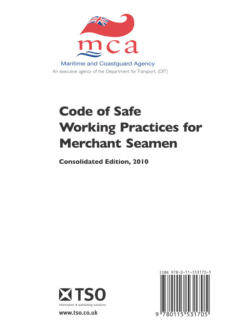

Authors: Vahid Hassani, Asgeir J. Sørensen, Antonio M.
Pascoal.
Abstract:
This paper proposes an adaptive solution for Dynamic
Positioning (DP) systems of marine vessels. The proposed
Robust Multiple Model Adaptive Dynamic Positioning
(RMMADP) structure consists of a bank of controllers
designed using the Mixed-µ methodology and an
identification unit. The latter is composed by a bank of
(steady-state) Kalman filters (KFs) that generate online the
output estimation errors (residuals) that are used to
generate appropriate monitoring signals.

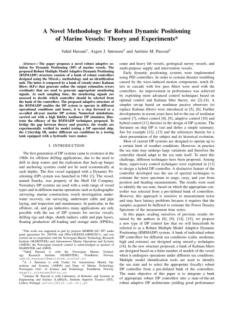

Authors: Tor A. Johansen, Torstein I. Bø, Eirik Mathiesen,
Aleksander Veksler, & Asgeir J. Sørensen
This document describes the principle of DP dynamic
energy storage and its benefits that result in reduced need
of diesel-generator maintenance, fuel consumption and
emissions, reduced risk for blackout, and increased
operational flexibility allowing power-consuming
operations such as drilling and lifting to be safely
prioritized over the Dynamic Positioning for short periods.

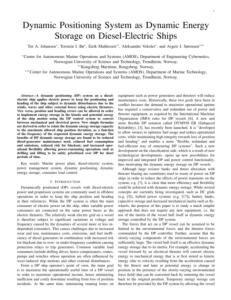

Authors: Aliz Szeile, Árpád Huszák, László Bacsárdi.
The authors proposed a monitoring network based on a
satellite segment and a wireless sensor-based ground
network. Also, they developed new algorithms to improve
the precision of the recursive positioning scheme utilized
in the proposed sensor network. A simulator tool was
implemented to analyze the introduced sensor network
architecture, evaluate its operation, and compare the
performances of different positioning algorithms.

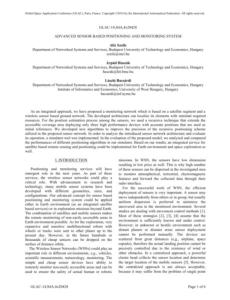

Authors: Zobair Ibn Awal, Kazuhiko Hasegawa
This paper focuses on maritime accidents due to engine
failure. Literature review suggests that a wide range of
accident theories have been developed over the years,
explaining the causes of accidents. Nevertheless, there
exist significant deficiencies in computational techniques
of accident prediction and analysis. Therefore, the authors
attempted to present a new method named Logic
Programming Technique (LPT). A modeling architecture is
proposed, which essentially utilizes search techniques to
deduce an accident and a sequence of events associated
with engine failure. A static knowledge base is
constructed following two actual marine accident cases to
explain the concept.

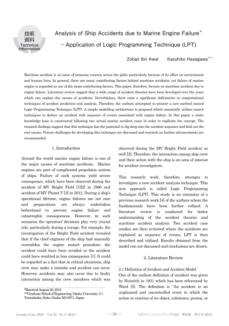

Authors: Adrew Scardino, Lyn Fletcher, John Lewis
Introduction:
There is an increasing need by the marine industries for
effective non-toxic control of fouling. One of the major
limitations of new fouling release coatings is that they
cannot protect structures whilst stationary and will not
release certain fouling organisms when vessels are
operating at low speeds. This is a major problem for slow
or infrequently moving vessels and for vessels docked in
tropical waters where fouling pressure is extreme. This
paper describes novel technology (provisional patent #
2008905482) to protect vessels whilst stationary using air
bubble curtains.



Publisher:
Australian National System for the Prevention and
Management of Marine Pest Incursions
Overview:
Along with most shipping and boating sectors in Australia,
non-trading vessels have been recognised as presenting a
risk of marine pest translocation and introduction via
biofouling. The voluntary biofouling management
guidance for non-trading vessels has been developed to
assist industry manage this risk.

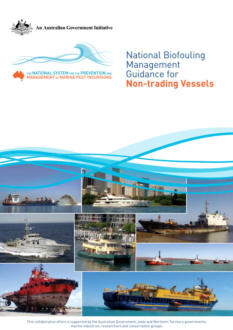

Publisher:
Australian National System for the Prevention and
Management of Marine Pest Incursions
Overview:
Along with most shipping and boating sectors in Australia,
the petroleum production and exploration industry
(henceforth referred to as the petroleum industry) has
been recognised as presenting a risk of marine pest
translocation and introduction via biofouling. The
voluntary biofouling management guidance for non-
trading vessels has been developed to assist industry
manage this risk.



Publisher:
Australian National System for the Prevention and
Management of Marine Pest Incursions
Overview:
Along with most shipping and boating sectors in Australia,
commercial vessels have been recognised as presenting a
risk of marine pest translocation and introduction via
biofouling. The voluntary biofouling management
guidance for non-trading vessels has been developed to
assist industry manage this risk.

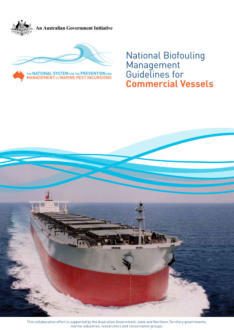

Author: Andrew Leach (University of Wollongong -
Australia)
Abstract
Biofouling within sea chests may be more important than
ballast water and hull fouling for dispersing certain non-
indigenous marine species (NIMS). Despite this, current
Australian guidelines remain costly, ineffective, or may
increase the biosecuirty risk of sea chests. This thesis tested
the efficacy of a new heated seawater biofouling
treatment technique on managing the biosecurity risks
posed by sea chests.

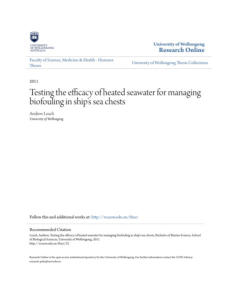

Author: Adnan Awad
The ASCLME project is funded by the Global Environment
Facility (GEF) and implemented by the United Nations
Development Programme (UNDP). Its goal is to ensure
the long-term sustainability of the living resources by
introducing an ecosystem-based approach to
management.
This report focuses on the countries of the Western Indian
Ocean (WIO) region participating in the ASCLME
programme, including Comoros, Kenya, Madagascar,
Mauritius, Mozambique, Seychelles, Somalia, South Africa,
and Tanzania.

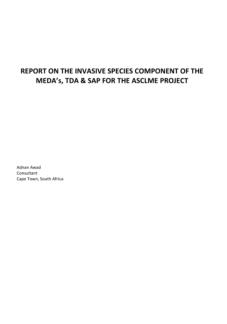

Published by the ministry for primary industries of New
Zealand,
This document is a list of approved ballast water treatment
procedures.

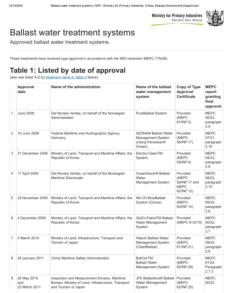


Authors: Abraham Growcott, Dan Kluza and Eugene
Georgiades for the New Zealand Ministry for primary
industries.
Vessel biofouling is a major pathway for the introduction
and spread of non-indigenous marine species. Sea chests
are cavities built into a vessel’s hull to help increase the
efficiency of pumping seawater into the internal pipework
system. Biofouling of the inner surfaces of sea chests can
occur through the entry of larval stages of sessile species
through the sea chest grates. As sea chests are protected
from a constant laminar flow of water, they tend to
accumulate higher biomass of organisms than general
hull areas. In addition to the transport of non-indigenous
species, the consequences associated with sea chest and
internal pipework biofouling include impacts to vessel
operational efficiency and crew safety.
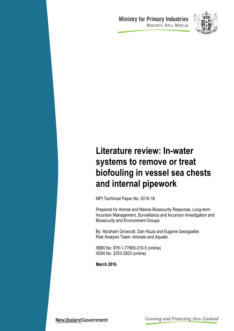

Authors: Piotr Balazy, Piotr Kuklinski, Jørgen Berge.
Photographic time-lapse techniques are especially useful
in the marine realm for visualising long-term processes
and remote monitoring of sites/objects/organisms where
the presence of researchers might cause some study bias
or access is limited or impossible. With rapid advances in
technology development, easy access to new tools for
time-lapse photography and setting up systems is relatively
inexpensive. The essential requirements for low-cost
autonomous time-lapse camera systems to be self-
sufficient and reliable enough to withstand the extended
deployment periods (up to one year) on the seafloor at
up to 50 m depth are presented. In this example, a
custom-made system developed initially for monitoring
the activity of filter/suspension feeders and scavenging
fauna in polar conditions is described.

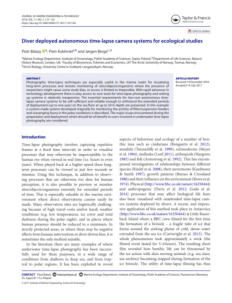

This Rule Note is applicable to lifting appliances fitted on
ships, floating supports, fixed or mobile offshore
platforms, and used for:
a) lifting in harbour or in similar conditions, i.e loading or
unloading cargoes, equipment, spare parts, or
consumable
b) lifting in offshore conditions for various lifting
operations, exclusive of the appliances mentioned in “c”
c) lifting in offshore conditions for launching and recovery
of subsea equipment.
In addition, this Rule Note may also be used for the
certification of lifting accessories and the verification of
lifting pad eyes.

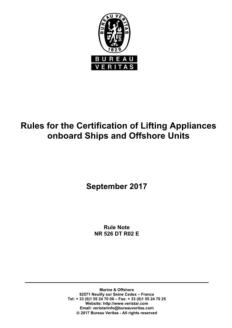

These rules incorporate the text in full of the “International
Code of Safety for High Speed Craft” (“HSC Code”)
adopted by the IMO Maritime Safety Committee, at its
73rd session, in December 2000, through Resolution MSC.
97(73).

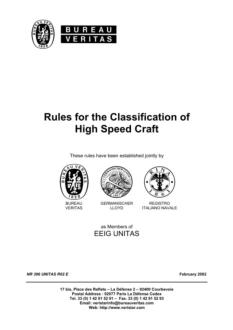

These rules provide requirements to vessels performing
particular operations, including sub-sea lifting, cable and
pipe laying services, heavy lift and transport, diving
support, seismographic research services, well stimulation,
fire-fighting, icebreaking, dredging, and towing and escort
services.

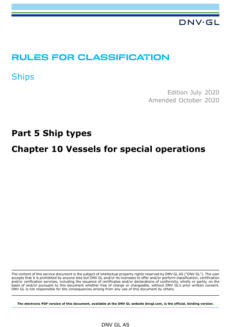

This document refers to DNVGL rules for classification of:
ships, high speed and light crafts, inland navigation
vessels, floating docks, mobile offshore units, yachts,
underwater technology, naval vessels.

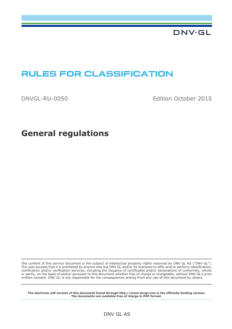

Lloyd's Register's Rules and Regulations set appropriate
standards for the design, construction and lifetime
maintenance of ships, offshore units and land-based
installations - providing all the information ownwers need
for classification purposes.






Author: Victor A. Dubrovsky
As a rule, a new multi-hull ship has nothing near enough
prototype as a base for dimension selection. It means the
technical characteristics of a new vessel must be
estimated by direct calculations.
Besides, wide possible ranges of dimension correlations
are the reason for the variant designing of multi-hulls.
Multi-hull ships are most economically effective as so-
named “capacity carriers”, i.e., are intended for
transporting any light cargo with a big needed area deck
or inner volume of the ship (as passengers,
wheeled vehicles, lightweight containers, science
laboratories, weapon systems).

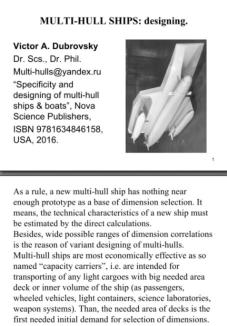


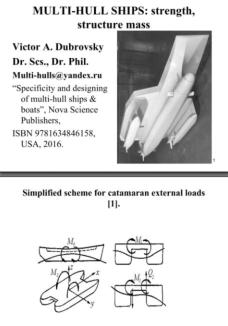

Authors: Jonathan T. Power, & António J. Simões Ré
The International Maritime Organization (IMO) Lifesaving
Appliances (LSA) code does not have criteria for the
maneuvering performance of lifeboats nor their
habitability and effects on human subjects.
This document discusses exercises conducted with a
SOLAS approved 20-person lifeboat by a coxswain and
his assistant wearing certified immersion suit systems.



Authors: B. Thomas, M. Hadfield, & S. Austen
This paper presents a methodology for assessing slipway
lining performance so that friction and wear conditions
along the slipway can be monitored to ensure
consistent operation. A multidisciplinary approach using
tribometer testing in conjunction with finite element
analysis and real-world slipway condition surveys is
adopted to extend the scope of the investigation to
incorporate common real-world effects such as panel
misalignments.

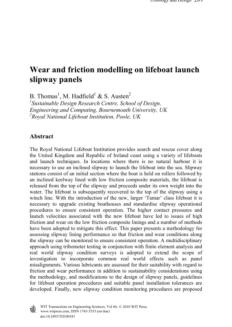

Authors:
Shaoyang Qiu, Hongxiang Ren, Haijiang Li, Yi Zhou, and
Delong Wang
For the design of ship equipment and crew training, it
would be useful to develop software for the three-
dimensional simulation of a totally enclosed lifeboat. To
improve the simulation accuracy and immersion of the
software, the authors present a multibody dynamics
model for a lifeboat lowered from a ship, accounting for
the coupled motion among the ship, lifeboat slings, a
cable-pulley system, and the lifeboat.

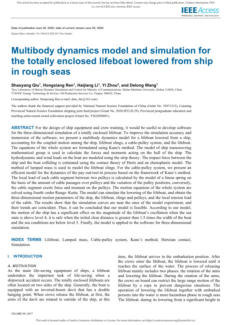

This guide has been published by the Oil Companies
International Marine Forum with the aim of providing
practical information to assist seafarers with the safe
operation and maintenance of survival craft.
Although the main focus of the guidance is directed at
personnel onboard, it will also be of interest to shore
managers and company superintendents having general
responsibilities for shipboard safety.

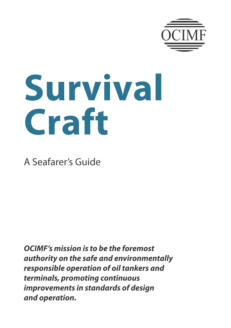

Publisher OSHA
This document presents guidance on preventing injuries
and illnesses from workplace hazards on barges.
It is not a standard or regulation and is only advisory and
intended to assist employers in providing a safe and
healthful workplace.

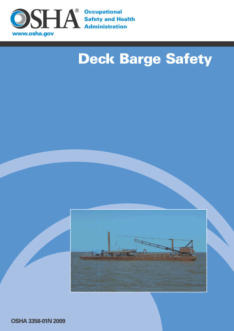

Author: Hirpa G. Lemu
Offshore cranes are designed for advanced installation
and offshore maintenance tasks.
While the crane's failure and the winch's foundation are
relatively easy to predict due to the existing solid
knowledge on the design and performance, how the
winch drum performs is often complex. One of the few
design criteria used in the industry is DNV Standard for
Lifting Appliances. This standard is not explicitly designed
for offshore winches but covers several different types of
winches that will naturally have other properties and the
forces acting on them will be different.

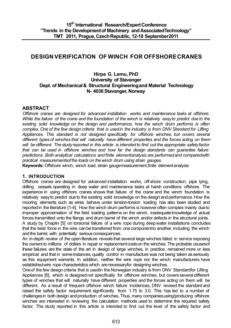

Author:
Karl-Heinz Rupp (Encyclopedia of Life Support System)
This document describes a ship's navigation in an
environment with air temperatures around and below
zero degrees Celsius. Under these conditions, the
following have to be expected: water with ice coverage,
snowfall, the icing on deck, and the freezing of water,
condensate, and other liquids on board the ship. The
vessel" s classification starts with no ice class for very easy
winter conditions and ends up with ice class for the high
Arctic.
Therefore the ship’s handling varies over a wide range
and must be adapted to the actual ice conditions and ice
class of the vessel.



Authors: Jerzy Herdzik
Heave compensation is a technique used to reduce the
influence of waves on a hull or only a part of the
equipment inside the hull. There are two types of heave
compensation: passive (PHC) and active (AHC).
The safety of these offshore activities is so crucial that the
area of power (using external energy) and non-power
(using only the energy of wave movement) drives are
quickly developed. The heave compensators allow for
increasing the weather window and better making use of
the offshore vessels.

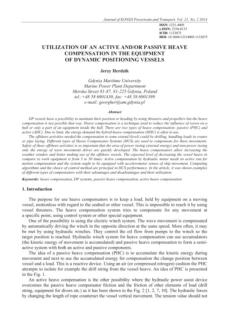

Authors: B.W. Nam, N.W. Kim, S.Y. Hong
The floating crane vessel in waves gives rise to the motion
of the lifted object connected to the hoisting wire. The
dynamic tension induced by the lifted object also affects
the motion responses of the floating crane vessel in return.
In this study, coupled motion responses of a floating crane
vessel and a lifted subsea manifold during deep-water
installation operations were investigated by both
experiments and numerical calculations. A series of model
tests for the deep-water lifting operation were performed.
The vessel with a crane control system and a typical
subsea manifold were examined for the model test.

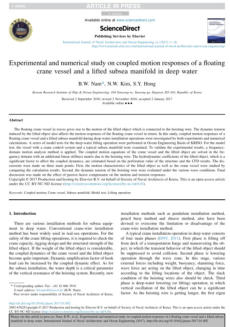

The US Navy has published the Cold Weather Handbook
for Surface Ships to provide information supporting
operational preparation for vessel deployments in such
areas.
Much of the information provided in this handbook can
be used by diving and ROV support vessels.

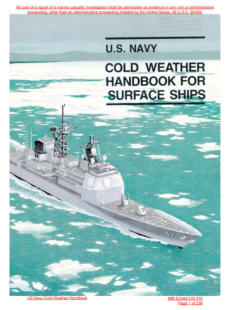

This document is a self-study course designed by the US
Navy to improve professional/ military knowledge. It
contains subject matter about day-to-day occupational
knowledge and skill requirements and includes text,
tables, and illustrations to help readers understand the
information.

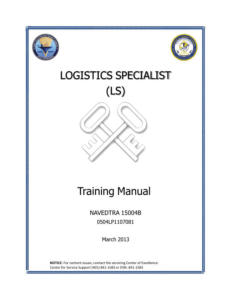



Click on the
octopus to return to
the top of the page


Publisher: Maritime New Zealand
This text intends to inform seafarers on New Zealand-
registered SOLAS ships about the Code of Safe Working
Practices for Merchant Seafarers to ensure that copies of
the Code are available on all such vessels and accessible to
any seafarer. The document outlines the Code's alignment
with relevant health, safety, and maritime regulations and
emphasizes the importance of understanding and
cooperation from both employers and employees for
effective implementation. Additionally, it provides an
overview of the Code's structure, divided into four key
sections.



Publisher: Oil Companies International Marine Forum
This document provides a detailed historical overview and
explanation of the SIRE (Ship Inspection Report)
Programme, including its inception, revisions, and
procedural elements. It outlines the establishment of the
program by OCIMF in 1993, its voluntary nature, and the
mechanisms for report distribution and feedback. It also
describes significant revisions made to the program over
the years, including the introduction of electronic report
distribution, uniform inspection procedures, and detailed
inspection questionnaires.

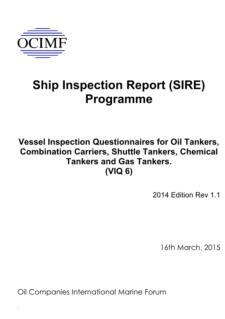

Authors: Yaser Sharifi, Hassan Ghassemi, Hamid Zanganeh
This document evaluates strategies for reducing fuel
consumption in the maritime shipping industry. It
highlights the impact of fluctuating fuel prices and stricter
emissions regulations by the International Maritime
Organization (IMO) on the industry. Also, it outlines two
main approaches for reducing bunker consumption:
optimizing ship construction (e.g., hull, propeller, rudder)
and reducing operational costs (e.g., controlling speed,
optimizing routes).

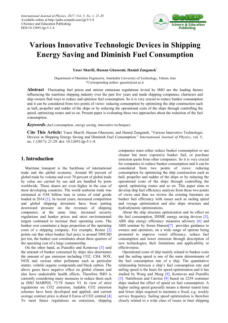

The aim of this report is to provide a qualitative assessment
of blast loading and failure for typical structural
arrangements of floating installations when subjected to
an idealized gas explosion loading. Four floating
installations are examined, referred to in this text as Vessel
A, B, C, and D. The structural response regime of the
structures is determined through modal analysis, and a
dynamic analysis is conducted for two load cases. The
structural responses of the four structures are then
compared based on their relative performance.

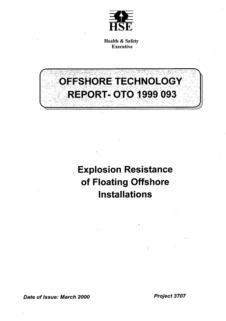

This paper is a comparative analysis of two different
routing policies for offshore supply vessels (OSVs) used by
oil companies. It discusses developing and using a
discrete-event simulation model to optimize fleet size and
composition, aiming to minimize costs while meeting
service-level requirements. It also highlights the
advantages of routing based on platform demands over a
fixed schedule, supported by experimental results.

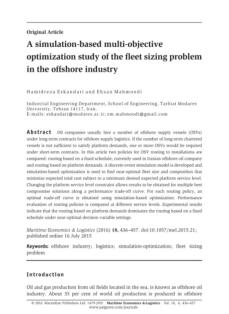


27 - US Patent: Marine vessel control system, marine propulsion
system, and marine vessel
Authors: Makoto Ito, Shizuoka
This marine vessel control system consists of a control unit,
a first communication bus, a second communication bus,
and an auxiliary device connection section. The control
unit outputs maneuvering control information and
backup information, while the first bus transmits control
information to the propulsion device. The second bus
sends backup information to the propulsion device. An
auxiliary device connection section connects auxiliary
information to the control unit.
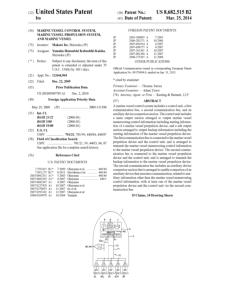


31 - US Patent: Vessel propulsion control apparatus and marine
vessel.
Authors: Yuji Hiramatsu, Shizuoka
This marine vessel propulsion control apparatus includes a
joystick unit and a control unit that controls the propulsion
and steering units. The joystick unit controls the hull's
heading direction and stem turning, while the control unit
maintains the steering angle when the output of the
propulsion unit is stopped.



39 - US Patent: Marine vessel propulsion system and marine vessel
including the same.
Authors: Yukinori Nose, Yoshiyuki Ichikawa, Makoto
Mizutani
This marine vessel propulsion system consists of two
propulsion devices, a first operation lever for
maneuvering, a second operation lever for controlling the
first, a position sensor for the second, and a control unit.
The control unit sets the target pivoting speed and travel
speed based on the positions of the levers.
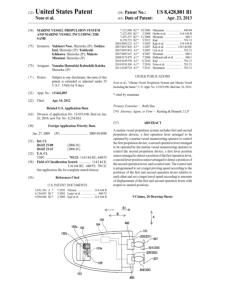



43 - An Energy Management System of a Fuel Cell/Battery Hybrid
Boat
Authors: Jingang Han, Jean-Frederic Charpentier, and
Tianhao Tang
This paper presents a hybrid fuel cell/battery power
system for a low-power boat, integrating a proton
exchange membrane fuel cell and battery bank. The
system uses mathematical models and simulations to
analyze dynamic performance and power allocation. An
efficient energy management system (EMS) is proposed
based on operation states, maximizing system efficiency.
Simulation results validate the system's adequacy for real
ship driving cycles.
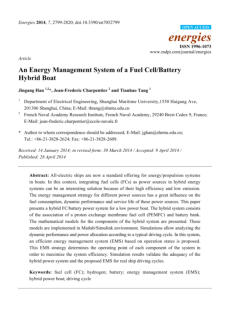


46 - US Patent: Vessel propulsion apparatus
Authors: Shintarou Kawaguchi
This vessel propulsion apparatus consists of a second
shaft, a first bearing, a second bearing, and an adjusting
member. The thrust applied to the second shaft is
transmitted via the first bearing and the first driven gear or
the second bearing and the second driven gear. The
apparatus also includes an adjusting member for
preloading.
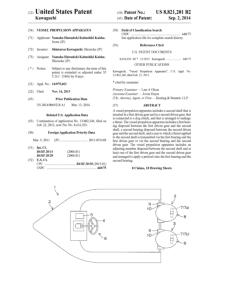


47 - US Patent - Hybrid propulsion system for a vessel
Authors: Torbjorn Haugland for Rolls Royce Marine
A hybrid propulsion system for a vessel includes main
engines connected via transmission and connection
devices, electrical machines connected via a connection
and disconnection device, and hybrid shaft generators
connected to the vessel's switchboards.
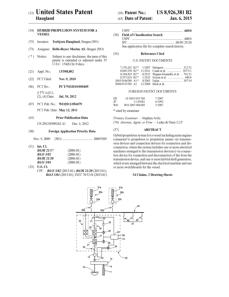


51 - An Analysis of Transient Overvoltages during the Energization
of Electric Ship Propulsion Systems
Authors: Morris Brenna, Federica Foiadelli, and Dario
Zaninelli
This paper analyzes resonance phenomena in an isolated
distribution system during transient events like repeated
energizations or power converter switching. It examines
the energization of an onboard radio distribution system
on an electric ship, determining leakage parameters
causing resonance problems.
